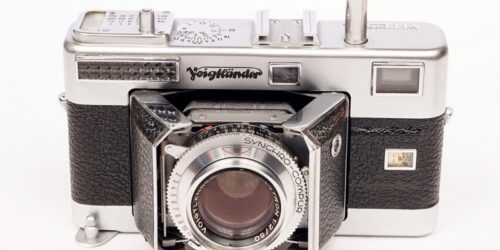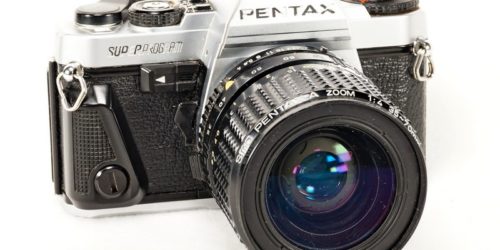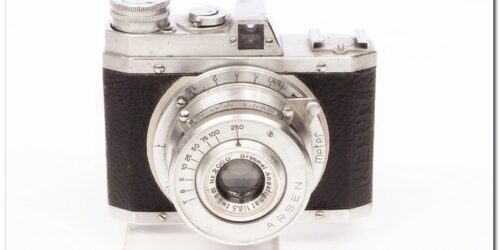Minolta Hi-Matic C
Minolta Hi-Matic C
In the technology world, a product is expected to improve with the introduction of new models. It is not always the case in the photography world. In the old world, say the post-war years, many camera makers set up shop with high hopes, only to realize that to keep pace with cutting-edge technology offered by the majors takes more than good intentions. It was typical for German and Japanese start-ups that hatched a good product to follow with a second-best, cheaper model, which led to a downward path.
The famed Hi-Matic line seems to be just that. Although Minolta was a solid brand and a market leader, to keep afloat in the crowded 35mm compact camera segment was tough. Similar models were offered by all camera makers, big or small, so an arms race ensued, with manufacturers competing to provide more features at a lower cost.
The Hi-Matic line began in 1962 with the introduction of the metal-bodied Hi-Matic, a manual mode rangefinder camera equipped with a selenium meter. Later models, the 7, 7s, 9 and 11 changed the meter to CdS, still similar cameras, offering manual and automatic modes. These models can be classified as the Hi-Matic classics. From there, Minolta changed its naming convention suffix, transitioning from numbers to letters, with a mix of classic and plastic bodies, while slipping into a more affordable camera class. From the Hi-Matic S of 1978 till the last Hi-Matic of 1984, all models leaned to the low-end, automatic point-and-shoot concept.
The Hi-Matic C on my desk is a mid-range model, positioned between the classic models and the late versions. It is a compact camera, a little sister of the classics. The body is primarily plastic, which makes it much lighter. It appears that all that was retained from the classics is the logo and the extra viewer borrowed from the Hi-Matic 11, as cited on that camera’s page as PIP. New for this model is a retractable lens that, once retracted, makes the camera pocket-sized.
The Hi-Matic C has a sister, the Hi-Matic 5, solely sold at JCPenney stores. The 5 is similar, except for the retractable lens, which was replaced with a fixed lens.
On paper, the Hi-matic C appears to be an easy-to-use, beginner’s camera. In reality, it is not so. It seems to be less popular than the other Hi-Matic models, based on the scant online mentions. It is, however, a subject of quite a few Japanese articles, which may suggest that it was popular there.
- The body is lightweight, mostly made of plastic, with a punched paper-thin steel top cover and back cover.
- The top features a self-reset frame counter, a hot accessory shoe, and the rewind crank, which doubles as the back release.
- The winder lever is an economy version of the solid lever found on the earlier models. It pulls the film and cocks the shutter, with a much shorter travel than the classics.
- Inside is all plastic, without the well-machined metal of the earlier models. Two cogs on the film path keep it well behaved, with a guide roller and a pressure plate on the back cover. The take-off spool is smaller than the one on the earlier models, and not as friendly.
- The bottom has the battery bay, featuring an unfriendly locking cover. I suppose it was easy to yield open when the camera was new, but once it becomes grimy with use, it takes some effort and perhaps a screwdriver to turn. To open, turn the lock halfway clockwise. Turning the other way will shear the pin that holds the lock.
- The viewer is large and bright, with a good parallax frame.
- The meter needle hovers at the viewer’s right, showing the aperture value selected by the camera. The meter wakes up with a trigger half-press.
- At the bottom left of the viewer, there is an additional lens showing the exposure values, described as a picture-in-picture, or PIP. The PIP lens is better pronounced than its predecessors and much clearer, yet it takes a hard squint to the bottom right to read it.
- It is difficult, if not impossible, to sight the composing frame, the meter scale and the PIP window at once. The concept could be reasonable, but the execution is poor.
- The PIP window aims at the front end of the lens assembly, capturing the exposure setting set against the dot at the front. The icon shown is distorted, kind of flattened.
- At the camera’s forehead is a prominent green button. Press it and pull the lens out. To retract, press it and push back the lens.
- The front viewer’s extra PIP window appears to be there by design, unlike the earlier model, which looked like a crack in the glass.
- The lens assembly carries only a few user settings:
- Being a viewfinder with no coupled metering, the distance dial is marked with three icons, symbolizing portrait, group and landscape. For the purist, down the same dial is a distance scale, marked in meters and feet. A finger rest supports the dial.
- The next dial features the shutter speed control, again abbreviated with icons representing sunny and cloudy conditions.
- On the same dial are GN values; when selected, it activates a flash mode. The GN values represent the flash gun’s ability, and the value to be set as found on the flash gun itself. Alternatively, consult the table printed on the camera back. True to Minolta’s naming tradition, the flash mode is so-called Flashmatic.
- The actual shutter speeds are mentioned in the user manual as 30 and 250, slim pickings for a camera of that generation.
- At the front face of the lens are the film speed settings, two levers marked ASA and DIN, moving in concert.
Using the camera is simple, but using it today as a shooter defeats the purpose, as there are few user controls. One may as well use a modern point-and-shoot camera rather than this clunky model. It represents an era between the early, fully manual cameras and the late automatic, yet controllable cameras. For the shelf, it could complete the Minolta Hi-Matic parade.
| Camdex list number | 5333 |
| Brand | Minolta |
| Model | Hi-Matic C |
| Manual | Butkus CJ’s Classic Cameras |
| Value | At camdex.ca |
| Format | 35mm |
| Introduced | 1969 |
| AKA | |
| Country | Japan |
| Qty made | |
| Initial price | |
| Currency | |
| Type | Viewfinder |
| Body material | Plastic |
| Mode | Auto |
| Weight | 425 gr, Body only |
| Class average weight | 475 gr, Body only |
| ASA range | 25-400 |
| Kit lens | 2.7/40 |
| Lens make | Rokkor |
| Filter size | 49 mm |
| Lens mount | Fixed lens |
| Mount size | N/A |
| Aperture | |
| Shutter | Leaf |
| Shutter make | Seikosha |
| Trigger | On top |
| Winder | Lever |
| Shutter cocking | Winder |
| Light meter | CdS, external, coupled |
| Loc | No |
| Speeds | 30, 250 |
| Mirror | N/A |
| Viewer | Viewfinder |
| DOF preview | No |
| Exposure lock | No |
| Exposure compensation | No |
| Shoe | Hot |
| External sync | X |
| Sync speed | 30 |
| Timer | No |
| Battery, original | 675 |
| Battery, replacement | AG13 |
| Battery voltage | 1.35 |
| Integral flash | None |
| Other | |
| More | |
| Service / repair links | See camerlog.com |



















